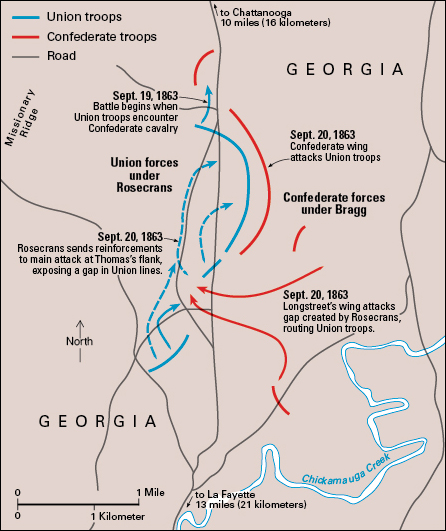Chickamauga, Battle of, was the Confederacy’s last important victory of the American Civil War (1861-1865). The battle, named after a creek on the battlefield, took place in northwestern Georgia on Sept. 19 and 20, 1863. General Braxton Bragg’s Confederate army of about 66,000 men defeated a Union army of about 60,000 led by General William Rosecrans.

In January 1863, following the Battle of Stones River (also called the Battle of Murfreesboro) in central Tennessee, Bragg’s Confederate forces retreated from Rosecrans’s Union army. Both armies rested until late June, when Rosecrans advanced toward Bragg. Bragg’s army, which was outnumbered, retreated 80 miles (130 kilometers) south to Chattanooga, Tennessee. On September 8, Bragg evacuated Chattanooga and retreated another 25 miles (40 kilometers) south to La Fayette, Georgia. At La Fayette, Confederate reinforcements arrived. Bragg now had an army larger than Rosecrans had.
With his army strengthened, Bragg planned to attack Rosecrans. Unaware of this, Rosecrans sent his army in three groups, spread out over 40 miles (64 kilometers), to pursue the Confederates. The groups were headed by Union Generals Thomas Crittenden, Alexander McCook, and George H. Thomas. Meanwhile, Bragg kept his army together and tried to destroy the separate portions of the Union army. In mid-September, Bragg twice ordered his subordinate generals to attack outnumbered Union groups, but both times his orders were not followed. Rosecrans soon became aware of the Union’s dangerous situation and brought the three groups closer together.
The Battle of Chickamauga began on September 19, when Union troops commanded by Thomas encountered Confederate cavalry at the northern end of the battlefield. Throughout the day, reinforcements arrived for both sides, and neither side gained a clear advantage. That night, Bragg divided his army into two wings, one commanded by General James Longstreet and the other by General Leonidas Polk.
On September 20, Polk’s wing attacked Thomas’s troops. Rosecrans responded by sending reinforcements from Crittenden’s and McCook’s groups to help Thomas. However, in reinforcing Thomas, Rosecrans created a gap in the Union lines just as Longstreet’s wing attacked. Confederate troops poured through this gap and routed the Union troops. Crittenden, McCook, Rosecrans, and much of the Union army fled north toward Chattanooga.
Thomas and his troops, however, held their position against repeated Confederate attacks, waiting until night to withdraw to Chattanooga. For this stand, Thomas received the nickname “The Rock of Chickamauga.”
Over the course of the two days of fighting at Chickamauga, the Union suffered about 16,200 casualties and the Confederates about 18,500. In October, Thomas replaced Rosecrans as the Union commander. Bragg decided to besiege the Union army in Chattanooga, where the two armies would fight again in November.
